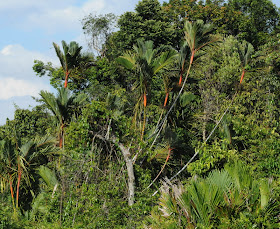Perhaps the most emblematic plant of Maludam's forest is the red sealing-wax palm (Cyrtostachys lakka). With its graceful, bright red stems, it is certainly one of the most attractive.
This little fellow, with the ridges on the top of its head and the attractive speckling below, is probably a swamp or four-ridged toad (Ingerophrynus quadriporcatus). Note that the parotid gland (the swelling behind the eye) is particularly long and narrow for a toad. The four-ridged toad lives in the leaf litter of lowland forests in Borneo, Sumatra and the Malay Peninsula.The trail brought us close to denizens of the forest floor that we could not have seen on our boat trip of the day before, including these graceful fungi.
I believe that this butterfly is one of the Junonias, or pansies - it is certainly a nymphalid.
Here is another, rather ragged nymphalid, and again I am not sure which. Several Bornean butterflies that perch on the forest floor share its pattern of somber brown marked with a few white flecks - a perfect match for a decaying, fungus-marked leaf.
As for this rather remarkable caterpillar, I have no idea what it will metamorphose into (of course, as I am writing this several moths after the fact, it has certainly already done so). It is a good idea to be careful of colourful caterpillars with fuzzy hairs - chances are they are toxic, and the hairs could be covered with stinging poisons. Perhaps not, in this case, but I wasn't prepared to find out!
Our bird sightings included the distinctive, if distant, silhouette of a Greater Racket-tailed Drongo (Dicrurus paradiseus).
Surely one sign of how important Maludam is to Sarawak is the presence - now so unusual in the "land of the hornbill" - of Black Hornbills (Anthracoceros malayanus). We saw a few pairs along the trail and at the park edge, including these very cooperative individuals.
Yeo's chief avian target was a genuine peatswamp specialty, the Hook-billed Bulbul (Setornis criniger). Here he is peering intently ahead of him, hoping against hope for one to cross his path.
For a long while, though, we had not a whiff of our bird. Bulbuls there were in plenty, noisily seeking tiny fruits in the treetops, often in mixed parties of several species -- but not one was a Hook-billed. This is a Buff-vented Bulbul (Iole olivacea), one of the more frequent species we came across.
It occurred to me -- and I said as much to Yeo and Kho -- that perhaps our search image was off. Perhaps the Hook-billed Bulbul was not a noisy, gregarious canopy-haunter like the others, but a quiet bird of the undergrowth?
And so it proved. When I fired off a few quick shots (one with flash, one without) of this bird as it sat quietly below eye level in the depths of the forest, I was not even sure that it was a bulbul. It dashed off before Yeo could do more than glimpse it (Kho missed it altogether), but the photographs prove that it was, indeed, the elusive (and quite un-bulbul-like) Hook-billed Bulbul.
A final bird of sorts, back on the road, was the body of this Dusky Munia (Lonchura fuscans), commonest of Borneo's endemic birds (undoubtedly because it is the only one that does not live in the forest) and a species, unlike the others, that does not need the protection of the park. For the other birds in this entry, I can only hope that Maludam remains more or less pristine.
A final bird of sorts, back on the road, was the body of this Dusky Munia (Lonchura fuscans), commonest of Borneo's endemic birds (undoubtedly because it is the only one that does not live in the forest) and a species, unlike the others, that does not need the protection of the park. For the other birds in this entry, I can only hope that Maludam remains more or less pristine.


















No comments:
Post a Comment